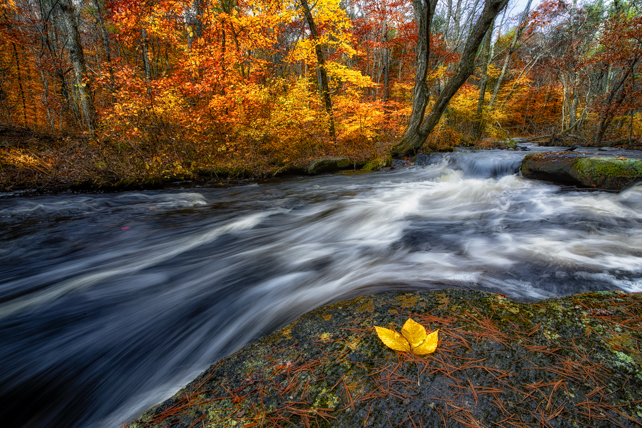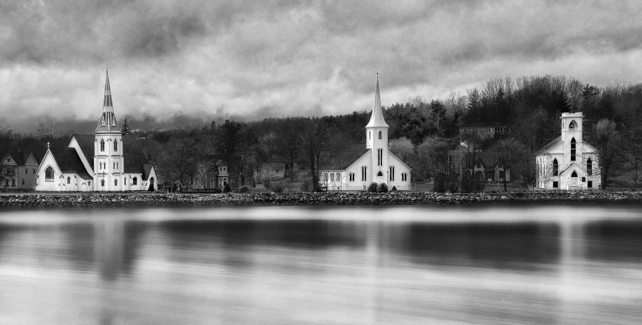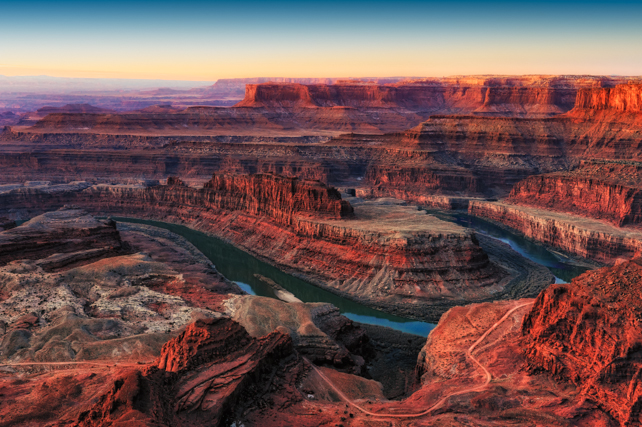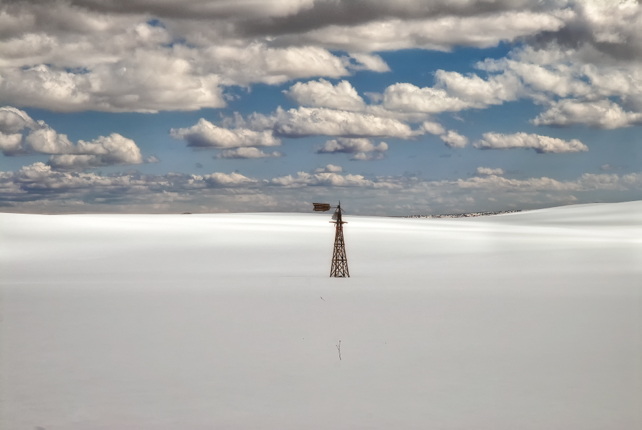What is the best lens for landscape photography? It depends. The same scene can be photographed with a wide angle, normal, or telephoto lens, all potentially yielding good images. Your artistic vision determines what is best for you. The following is my thought process of how I make my lens choices.
For me it depends on the background and the foreground I choose to use. The background typically is the main subject, the reason I am there to take the picture. The foreground is a second subject that complements the background. The focal length of the lens I choose along with the distance from the camera to the foreground determines the perspective, the size relationship between the foreground and background in the image. So my lens choice is not so much for angle of view, but for perspective between the foreground and background.
Super Wide Angle
For grand landscapes, focal lengths from 14mm to 28mm are typical for full frame, and 10mm to 18mm for crop sensor cameras. In the grand landscape style of shooting, composing the picture consist of using two main subjects, the background and the foreground. The foreground subject draws the eye into the image and then leads it to the background. The rule of thumb is the wider the angle of the lens the closer the camera should be to the foreground subject. The foreground in the picture often dominates the background, becoming the main subject in the picture.
For example, with a 14mm lens on a full frame camera, set at f/16 and a focused distance of two feet, everything in the photo from 1.0 foot to the horizon will be in focus. The emphasis will be on the foreground, as the wide angle perspective will make the foreground disproportionately large relative to the background, the wider the angle of the lens, the greater the effect. The wide-angle perspective gives depth, a three-dimensional look, to a two-dimensional photograph. This depth gives the viewer the impression they could walk into the photo. Lowering the height of the camera emphasizes the feeling of depth.
In the photo of the Yellow Leaves above, there were three visual elements in the scene I wanted to balance, the foreground with the three yellow leaves, the flowing water, and the background with all the leaves on the branches. The image was shot with a full frame camera with a 14mm lens. The camera was approximately 18 inches from the three yellow leaves in the foreground . By using such an extreme wide angle of view and placing the camera close to the foreground I forced the perspective allowing the three leaves in the foreground to balance against the many in the background.
Moderate Wide Angles to Normal
The moderate wide angle to normal focal lengths of 28mm-70mm for full frame, and 18mm-55mm for crop sensor cameras are useful when the subject emphasis in the scene is on the background. A foreground element can be used but it will not dominate the photo. Photos taken with a moderate wide angle have a natural look and feel to them. This is the focal length range of the lens that comes standard with most cameras. As this is the lens that most photographers have and use, a great many images are taken with it. This normal perspective is what people are accustomed to seeing. I try to produce images that stand out from the norm by composing with a contrasting foreground and a background subject.
In the picture above of the three churches, the foreground is the water, and the background is the sky and the three churches. My goal is to find a way to contrast the foreground and background. The clouds had great texture so I decided to remove the texture from the water by using slow shutter speed. The result is, the three churches held between the calm and the storm. This is and old image of mine that was shot with my first DSLR, the Nikon D70 with the kit lens, the 18mm-70mm. The focal length was 45mm.
For the picture above of Dead Horse Point in Canyonlands National Park, I used the man-made road in the foreground to contrast with the great winding nature made landscape behind it. The light of sunrise gave me contrasting colors, the cool blue of the top of the sky and the reflection of the sky in the water, against the warm yellow light on the horizon and the resulting orange glow of the rocks.
When I initially set my camera for the shot I had the 14mm-24mm lens, being that I was already a great distance from the scene, the resulting view thru the finder made everything appear too far away even at the 24mm setting. Switching to the 24mm-70mm I composed to include the road at the bottom of the picture entering at the bottom left, disappearing behind the rocks and then reappearing and looping down to the bottom edge of the frame. Also, I included just enough of the blue sky to match with the blue sky reflection in the water. I ended up with a focal length of 36mm, shot on a D700 full frame camera.
Telephotos
Telephoto lenses, 70mm and longer need not be left at home, they too have their place in landscape photography. With their depth compression and narrow angle of view they can isolate and showcase the subject of your choice. For vignettes and close ups, the short telephoto range, 70mm to 200mm, is my favorite. I use it to simplify the composition and isolate a subject from the background.
Composing with a foreground element and a background element is something I always try to do even when using telephoto lenses. Looking closely at the picture of the windmill, you will notice two small sticks (weeds) sticking up through the snow in the bottom half of the picture, my foreground subjects. The telephoto lens perspective, in compressing or flattening the image, makes it appear almost more like an illustration than a photograph. The image was shot with a crop sensor camera at 80mm.
The Lenses I Use
Currently I am using two cameras, a full frame Nikon D800 and a crop sensor Nikon D7000. Primarily I photograph nature and landscape subjects, I choose lenses trying to meet the following criteria: the lens should be sharp edge to edge, corner to corner. Foreground corners are important. They don’t necessarily have to be as sharp as the center but they must be sharp enough as to not call attention to themselves.
The ability to maximize depth of field by using apertures of F11 and F16, (and F22 on full frame), while maintaining satisfactory sharpness, is important. Lenses are sharpest in their middle apertures, around f 8.0, and have declining sharpness as the lens is stopped down. So as a lens is stopped down to increase depth of field, the overall sharpness declines. Image quality at these f-stops is just as important to me as well as how a lens performs wide open. I strongly recommend getting a depth of field app for your smart phone. If you are going to shoot with the foreground/background style of composition, the depth of field app will help you determine depth of field associated with lens focal length, f/stop, and camera to subject distance.
Linear distortion, vignetting, and chromatic aberration are not deal breakers, most image software can correct for them.
The lenses I use range from 10.5mm to 300mm. For many years I have used prime lenses. They are for the most part sharp, fast and compact. Now days I am shooting mostly with zooms. Using zooms I spend less time changing lenses and more time getting the shot right.
For the D7000 my primary lens is the Nikon 16mm-85mm. I like shooting wide and the extra reach on the bottom end makes it equivalent to 24mm on full frame. I find the range of this lens is just about perfect for the photography I do in New England. However when I am out west in the Zion, Bryce, and Arches areas in Utah, a super wide is added. Also in the bag with the D7000 is a Nikon 70mm-300mm and just for fun, the Nikon 10.5mm fisheye.
For the D800 my primary lens is the Nikon 24mm-70mm f2.8. This lens has replaced a bag full of primes. Some of the primes might be a little sharper, but for overall image quality and versatility the Nikon 24mm-70mm is superb. For the super wide I choose the Nikon 14mm-24mm zoom for its excellent sharpness and ultra wide view. On the telephoto side I use a Nikon 80mm-200mm f2.8.
So what is the best lens for landscape photography? It depends on the subject and your vision. My preferred style of composition is the grand landscape, so normal to super wide lenses are appropriate. When I am shooting the details or intimate landscapes normal and telephoto lenses are appropriate. Your style may dictate different choices. Whatever lens you have and use is the best lens. Explore the possibilities of what you already own. After determining what you can’t do with your current lenses you will have an idea of what your next lens should be.
Enjoy,
Michael Rice
Personal website www.twistedtreephoto.com
Hunts Photo and Video Providence, RI



